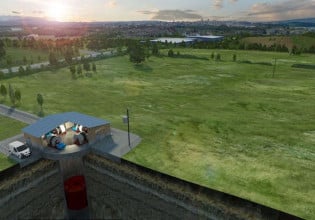AI-Based Platform Predicts Electrical Transformer System Failure
Charles River Analytics’ AI-based predictive maintenance platform for transformers recently landed a Small Business Innovation Research contract.
Massachusetts-based research and development agency and government contractor Charles River Analytics recently received a $1.1 million Small Business Innovation Research (SBIR) Phase II contract to provide a predictive maintenance diagnostic platform for electrical transformers.
Charles River Analytics recently nabbed a contract from the Small Business Innovation Research Phase II program. Image used courtesy of Charles River Analytics
The company’s Probabilistic Operations Warranted for Energy Reliability Evaluation and Diagnostics (POWERED) tool pulls large volumes of transformer data to diagnose equipment health and predict future system failures—preventing power shutdowns and costly equipment repairs to electrical infrastructure.
POWERED’s artificial intelligence-based predictive model analyzes a range of data points, including ambient temperatures, the composition of dissolved gasses in oil, electrical loading, and the temperature of oil used as a cooling encasing agent. Transformer health can also be assessed using dissolved gas analysis, a process typically conducted once or twice per year that has now been streamlined through modern software to sample oil hourly.
Condition-based monitoring platforms alert transformer operators to degradation in the system and flag areas to send crews for maintenance. Charles River Analytics claims its proactive maintenance could save millions that would otherwise be spent on replacing damaged equipment and restoring downtime.
The platform also runs on a hybrid approach using two data models—one capturing physical phenomena and the other using data-driven simulations. Blending the pair creates a unified model via Scruff, Charles River’s modeling framework that integrates multiple models and different types of sensor data. With POWERED’s modular dashboard, users can study the correlations between variables for faster decision-making.
How POWERED Works: Probabilistic Programming
POWERED was initially developed as a tool for the military, but distribution and power companies would represent a major end-market for the technology. Additionally, with user-tested improvements implemented, POWERED could expand beyond servicing transformers to other types of equipment.
In developing POWERED to help operators improve the reliability of their equipment, Charles River Analytics partnered with City Light & Power, a Colorado-based company providing distribution infrastructure systems and maintenance services to utilities and electric co-ops nationwide.
Charles River also tapped Sanja Cvijic, a computer scientist and power systems expert, in January 2020 to help lead POWERED’s development. Cvijic’s work focused on probabilistic relational models using non-deterministic algorithms to address challenges arising from the ongoing integration of renewables into the power grid. For example, non-deterministic models can parse through the uncertainty of weather forecasts to inform which load-balancing approach works best to manage sudden shifts in demand. This is useful in wind and solar photovoltaic power systems, where the energy supply is intermittent.
POWERED runs on Scruff, Charles River’s open-source programming language that combines physics, neural, and probabilistic models to inform a comprehensive framework allowing users to interchange model components and consider uncertainty in their decision-making.
Other Probabilistic Applications
Besides POWERED, Charles River’s other probabilistic programming products span several industries, from preventative maintenance to addressing challenges in supply chain logistics to identifying malware attacks, assessing the health of combat vehicles, and even predicting human behavior.
For example, its Real-time Assessment and Predictive Status (RAPS) maintenance system monitors robotic combat vehicles and predicts the conditions of their components and subsystems. Another tool, called Wildfire Integrated Modeling, Prediction and Learning Environment (WIMPLE), uses hybrid AI to assess wildfire risk factors and provide mitigation recommendations.
Charles River Analytics’ wildfire risk assessment platform, WIMPLE, shows vulnerability zones and mitigation options (on the left) and detailed views with property, region, and fire information (right). Image used courtesy of Charles River Analytics
Government Contracts
While private companies comprise part of its customer base, the public sector is Charles River’s main business, nabbing government contracts with the U.S. Department of Defense (DOD), the National Aeronautics and Space Administration, and the National Institutes of Health. According to the company’s website, 96% of its revenue in 2021 came from its role as a direct-prime contractor with the government; the remaining 4% was attributed to its subcontractor role, working with other companies and institutions to support development work for federal clients.
Charles River Analytics’ federal awards by program/phase, year, and agency. Image used courtesy of the Small Business Administration
POWERED will be utilized as part of a contract from the SBIR program, a division of the U.S. Small Business Administration. Charles River’s other tools have attracted several federal awards, including nearly 800 totaling $295.8 million from the DOD. And in 2022 alone, the company nabbed 33 government contracts topping $13.3 million, according to SBIR.


_tool_.jpg)






